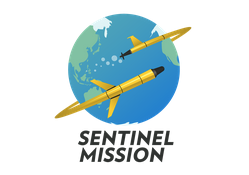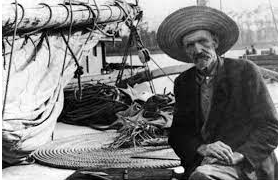Mission Statement
The Sentinel Mission is a daring scientific endeavor aiming to make history by completing the first circumnavigation journey by an autonomous underwater vehicle (AUV). Through the use of next-generation technology fueling the Sentinel AUV, ocean observation in the modern age can be revolutionized to support the New Blue Economy and Beyond serving as a proof-of-concept, the Sentinel Mission stands to promote a sustainable, equitable, and inclusive ocean for all.

Timeline
Henry Stommel basement
- Henry Stommel’s basement is where the idea of the ocean glider was created. Year (1996)
- Henry Stommel’s published article (1996) – This article is the starting point of a partnership between Henry Stommel and Douglass C. Webb, found of Teledyne. The Slocum glider was created and named after Joshua Slocum.

Joshua Slocum was the first person to single-handedly sail around the world. His achievement led to the glider being named after him.
Rutgers 1999 -launched its first gilder (glider 1)
Crossing of the Atlantic- Rutgers University scientists and students launched a robotic underway glider off the coast of New Jersey. Named RU27, the glider was the first to cross the Atlantic Ocean.
Outreach Crosscut
Members: Sal Fricano, Paul Alves, Trevor Barry, Mox Engelman, Megan Murie, Bella Fowler, Maddy Ripper, Becca Sangmeister, Joshua Cleary
Email Drafts
———-Email Draft – V_Alumni———-
Dear _____,
On behalf of the Department of Marine and Coastal Sciences at Rutgers University, The State University of New Jersey, we would like to cordially invite you to become an ambassador for the Sentinel Mission – the world’s first circumnavigation journey by an autonomous underwater vehicle.
In 2009, a team of faculty and undergraduate students at Rutgers University’s Department of Marine and Coastal Sciences, in conjunction with Teledyne Marine and the National Oceanic and Atmospheric Administration (NOAA), successfully completed the first Atlantic crossing with an autonomous underwater vehicle, which marked a major milestone in the capabilities of ocean observation. Now, 15 years later, technological advancements have led to the development of the Sentinel glider from our partners at Teledyne Marine, which is a robust next-generation glider engineered with the intent of undergoing long-duration science missions across the world. In anticipation of the Sentinel glider’s upcoming maiden voyage, our team of undergraduates believe that it is integral to the success of the Sentinel mission that we establish partnerships with distinguished individuals, groups, and organizations such as yourself.
Beyond serving as a proof-of-concept for how new technologies can serve ocean observation networks across the globe, the Sentinel mission stands for far more than just science. Due to the global reach this technology has, data collected through the Sentinel glider and its future fleet will stand to serve communities everywhere through equitable and inclusive means. A successful first journey of the Sentinel glider is not a win for one, but for all.
As an ambassador, we would greatly appreciate your social and/or financial support of this project as it finishes development and begins to make way for deployment. The prestige and outreach you and your organization have would be a priceless asset for us in working to spread the word about this major scientific journey we are undertaking to promote a sustainable, profitable, and scientifically understood ocean for all people across the globe. Through your inclusion in our team of researchers, students, and diverse individuals from across the world, we will continue to progress further in spreading awareness about this historical scientific undertaking and its positive implications for communities everywhere.
Thank you very much for your time and consideration. We look forward to hearing back from you and further discussing our path to partnership.
Kind Regards,
The Undergraduate Students of Topics in Marine Science
Department of Marine and Coastal Sciences
Rutgers, The State University of New Jersey
———-Email Draft – V_Donors———-
Dear _____,
On behalf of the Department of Marine and Coastal Sciences at Rutgers University, The State University of New Jersey, we would like to cordially invite you to become an ambassador for the Sentinel Mission – the world’s first circumnavigation journey by an autonomous underwater vehicle.
XXX
Thank you very much for your time and consideration. We look forward to hearing back from you and further discussing our path to partnership.
Kind Regards,
The Undergraduate Students of Topics in Marine Science
Department of Marine and Coastal Sciences
Rutgers, The State University of New Jersey
———-Email Draft – V_Organizations———-
Dear _____,
On behalf of the Department of Marine and Coastal Sciences at Rutgers University, The State University of New Jersey, we would like to cordially invite you to become an ambassador for the Sentinel Mission – the world’s first circumnavigation journey by an autonomous underwater vehicle.
XXX
Thank you very much for your time and consideration. We look forward to hearing back from you and further discussing our path to partnership.
Kind Regards,
The Undergraduate Students of Topics in Marine Science
Department of Marine and Coastal Sciences
Rutgers, The State University of New Jersey
———-Email Draft – V_International———-
Dear _____,
On behalf of the Department of Marine and Coastal Sciences at Rutgers University, The State University of New Jersey, we would like to cordially invite you to become an ambassador for the Sentinel Mission – the world’s first circumnavigation journey by an autonomous underwater vehicle.
In 2009, a team of faculty and undergraduate students at Rutgers University’s Department of Marine and Coastal Sciences, in conjunction with Teledyne Marine and the National Oceanic and Atmospheric Administration (NOAA), successfully completed the first Atlantic crossing with an autonomous underwater vehicle, which marked a major milestone in the capabilities of ocean observation. Now, 15 years later, technological advancements have led to the development of the Sentinel glider from our partners at Teledyne Marine, which is a robust next-generation glider engineered with the intent of undergoing long-duration science missions across the world. In anticipation of the Sentinel glider’s upcoming maiden voyage, our team of undergraduates believe that it is integral to the success of the Sentinel mission that we establish partnerships with distinguished individuals, groups, and organizations such as yourself.
Beyond serving as a proof-of-concept for how new technologies can serve ocean observation networks across the globe, the Sentinel mission stands for far more than just science. Due to the global reach this technology has, data collected through the Sentinel glider and its future fleet will stand to serve communities everywhere through equitable and inclusive means. A successful first journey of the Sentinel glider is not a win for one, but for all.
As a part of the global scope of this mission, we want to ensure that we build strong and positive international scientific and cultural connections. To this end, we would be honored if you would be an ambassador with us, not only for the __ leg of this mission when the glider will pass/arrive in your country, but also throughout this project as a part of our team.
As a part of our team, we would include you in a list of important people on our new Sentinel Mission website, and would work with you to include students and scientists on your end. From you, we would request information regarding the best places to port, the seasonal and long-term state of local flora and fauna, and what if any policies/restrictions we should be aware of regarding travel through your country’s waters.
XXX
Thank you very much for your time and consideration. We look forward to hearing back from you and further discussing our path to partnership.
Kind Regards,
The Undergraduate Students of Topics in Marine Science
Department of Marine and Coastal Sciences
Rutgers, The State University of New Jersey
